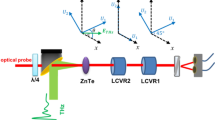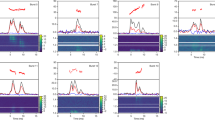Abstract
MEASUREMENTS of the group height and sense of rotation of the polarization ellipse by Brunnschweiler1 in the swept frequency-range of 100–1,000 kc./s. have frequently displayed an interference pattern similar to those shown by the records of Fig. 1. This is an ordinary h′–f record to which has been added a sense of rotation indicator; corresponding to a dark trace, the echo polarization is a north into east rotation (N→E) while the light trace refers to the echo having a north into west rotation (N→W). Further details on the recorder design have been given by Carlson2.
This is a preview of subscription content, access via your institution
Access options
Subscribe to this journal
Receive 51 print issues and online access
$199.00 per year
only $3.90 per issue
Buy this article
- Purchase on Springer Link
- Instant access to full article PDF
Prices may be subject to local taxes which are calculated during checkout
Similar content being viewed by others
References
Brunnschweiler, A., and Carlson, H. N., Nature, 188, 217 (1960).
Carlson, H. N., Sci. Rep. No. 129, Ionosphere Res. Lab., Pennsylvania State Univ.
Ratcliffe, J. A., Magneto Ionic Theory (Cambridge Univ. Press).
Seddon, J. C., Tech. Note D-1043, Nat. Aeronautics and Space Admin., Washington, D.C.
Elling, W., Archiv Elektrischen Übertragung, 15, 115 (1961).
Author information
Authors and Affiliations
Rights and permissions
About this article
Cite this article
FERRARO, A., TOU, C. Identification of Sporadic-E from Low-Frequency Sweep Polarization Records. Nature 193, 461–462 (1962). https://doi.org/10.1038/193461a0
Issue Date:
DOI: https://doi.org/10.1038/193461a0
Comments
By submitting a comment you agree to abide by our Terms and Community Guidelines. If you find something abusive or that does not comply with our terms or guidelines please flag it as inappropriate.



